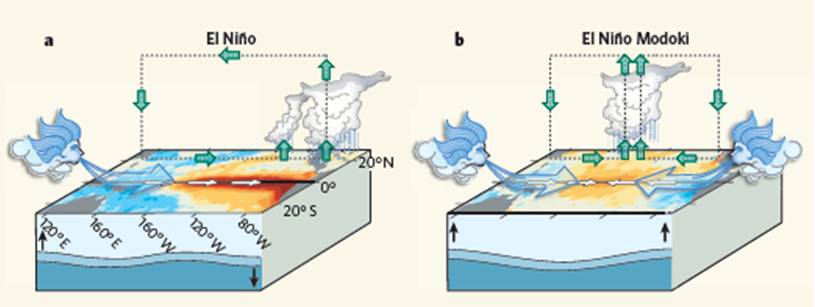El Niño ‘Modoki’ – a new kind of El Niño will increase with global warming

Research published today in Nature has identified a new type of El Niño climate anomaly that is occurring with more and more frequency as a consequence of human-induced global warming.
In the classic El Niño pattern, weak trade winds lead to unusually warm surface sea temperatures in the tropical eastern Pacific. In the altered El Niño, a region of warm ocean in the central Pacific is flanked on the east and west by unusually cool waters. This new pattern has been dubbed El Nino ‘Modoki’ — a Japanese word meaning ‘similar, but different’.
The researchers, led by Sang-Wook Yeh of the Korea Ocean Research & Development Institute conclude that the new type of El Niño will happen five times more often by the end of this century. They expect it to cause major shifts in global climate patterns, including more effective forcing of droughts in Australia and India.
We asked scientists to comment on the significance of this news for New Zealand and our global understanding of climate trends.
Dr Brett Mullan, Manager of the Climate Variability Group at NIWA comments:
“There is an ongoing debate in the scientific literature about whether global warming will lead to more “El Nino-like” circulation changes in the Pacific or not. However, when assessing impacts it is even more important to recognise that not all El Ninos are the same and can produce different climatic responses in countries around the Pacific rim such as New Zealand. The Yeh et al paper (Nature, 2009) essentially addresses this second aspect and provides evidence that El Nino “Modoki” events will become more common in future.
“The word “Modoki” is a Japanese term to describe something that is “similar but different”, and was first introduced to explain the unusual climate anomalies experienced in Japan in the 2004 El Nino, but the term has only became widely known internationally since 2007. A Modoki El Nino has the maximum sea surface warming in the central equatorial Pacific as opposed to the eastern Pacific (the “classical” El Nino). Modoki El Ninos have become more common since 1990, and other recent research suggests the associated rainfall and temperature anomalies are slightly different for Australia and New Zealand than for the classical eastern Pacific El Nino.
“So this new study suggests useful avenues of research on future New Zealand climate variability. For example, we know that El Ninos substantially reduce the likelihood of a tropical cyclone affecting New Zealand as it exits the tropics into mid-latitudes. But we don’t know how Modoki El Ninos differ from classical El Ninos in this regard.”
Dr James Renwick, Principal Scientist, Climate Variability & Change, NIWA comments:
“The paper by Yeh et al provides some very interesting dynamical insights into the changing nature of the El Nino cycle under climate change, showing how weakening trade winds combined with changes in the temperature structure of the Equatorial Pacific Ocean could lead to El Nino events preferentially being centred farther west.
“It is a welcome addition to the literature, as there has been much uncertainty about the future of El Nino as the background climate changes. El Nino plays such an important role in modulating year-to-year climate variations in different regions (such as New Zealand), it is vitally important to understand how the El Nino cycle will change in the future.”